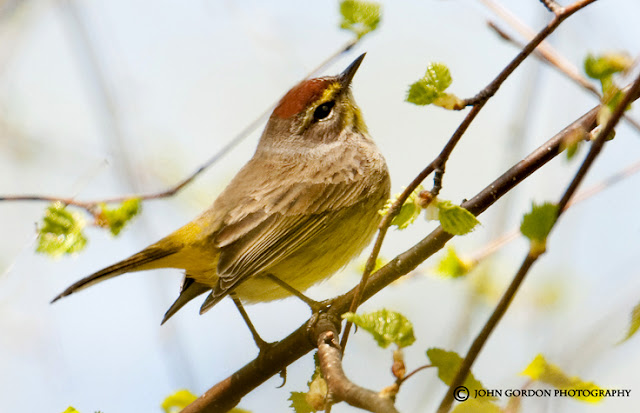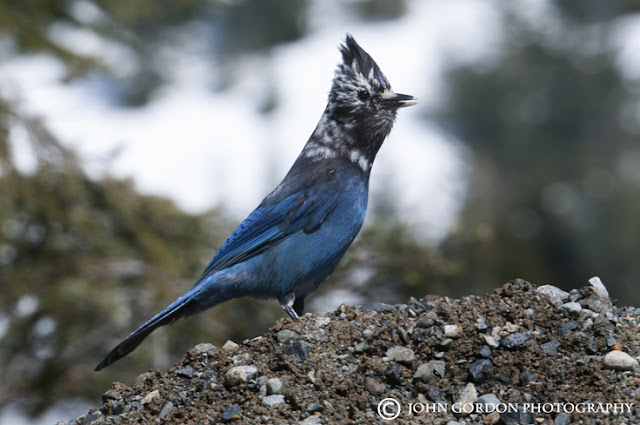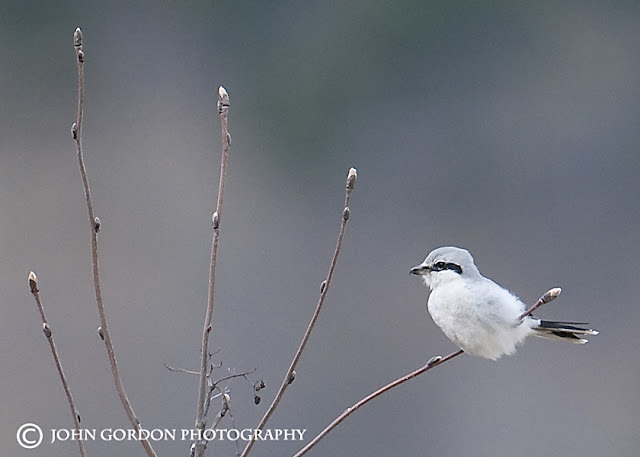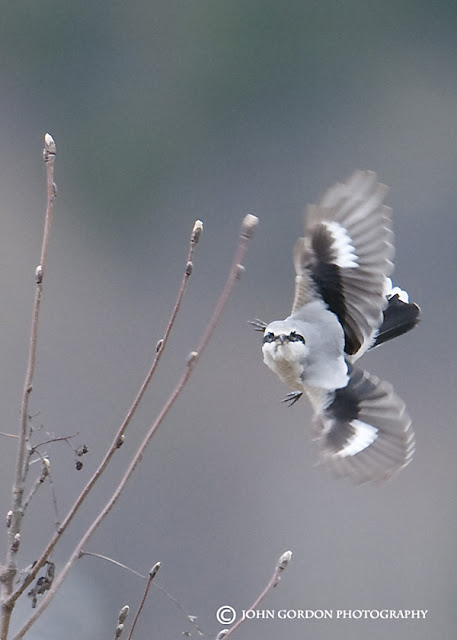"The bluebird carries the sky on his back" Henry David Thoreau April 3, 1852
Sunday, 28 April 2013
Watching Bird Migrations on Radar
Watch birds migrate into the Vancouver and Victoria area via radar. It's fascinating.
Read more about this in Derek Lovitch's book
"How to be a Better Birder ISBN 978-0-691-14448-1
Thanks to Ann Nightingale (great name for a birder) for the link
Pacific Northwest Bird Migration on Radar
Tuesday, 23 April 2013
Leucistic Steller's Jay ?
April 23/2013 Hemlock Ski Resort. Sunny
I am asking if anyone can shed light on this bird's markings. I believe it to be a Leucistic Steller's Jay.
The bird can be found easily next to the office just before the chair lift. Take some offerings and you'll find the flock. Also present are a few Gray Jays.
leucistic |luːˈsɪstɪk| adjective Zoology
(of an animal) having whitish fur, plumage, or skin due to a lack of pigment.
I am asking if anyone can shed light on this bird's markings. I believe it to be a Leucistic Steller's Jay.
The bird can be found easily next to the office just before the chair lift. Take some offerings and you'll find the flock. Also present are a few Gray Jays.
leucistic |luːˈsɪstɪk| adjective Zoology
(of an animal) having whitish fur, plumage, or skin due to a lack of pigment.
 |
| Steller's Jay (possibly Leucisitic) |
Dickcissel, Palm Warbler and Orange-crowned Warbler
The Dickcissel has only been reported in British Columbia twice and never in the Vancouver area. When the news that one had been spotted at a feeder in Ladner the "twitch' was on. I was lucky enough to see the bird in the first five minutes, I didn't have time to set my camera up and had to wait until later in the day to get the shot below.
 |
| Dickcissel (Spiza americana) |
 |
| Adult breeding Palm warbler (Dendroica palmarum) |
After loosing the Palm Warbler in the treetops a quick check of the park trail produced eight OCW and then it was time to get back to Ladner for another try for Dicksissel (shot at the top of this page) A big thanks to George Clulow for making me aware of the the Palm warbler and yet another new location to explore.
 |
| Orange-crowned warbler (Vermivora celata) |
LUCK: The shot of the Dickcissel that leads off this blog is a 'Lucky' shot, I almost missed it! Between Ladner and then Richmond and back to Ladner it had been a long day. After six hours I still didn't have a decent shot so I joked to the birders around me that the Dickcissel will arrive as soon as I take my camera off the tripod, sure enough, within seconds the bird perched on a branch about 20 metres away, the closest it had been it all day. I shot it with my 500mm handheld and a 1x4 converter, quite a handful.
Sunday, 21 April 2013
Great Horned Owlet
Beach Grove Park, Tsawwassen, B.C. April 19 2013
High up in a popular tree a Great horned owlet stretches a wing and stretches out a hideous looking set of yellow talons. I wouldn't want to be on the receiving end of those!
The young bird acts like any juvenile would, constantly nudging the sleeping mother, trying all kinds of tricks to wake her up. Now, if only the adult would turn around for the perfect portrait. The owlet, which can only be a few weeks old eventually turns around and faces me. A third owl, the male can be seen preening in a nearby fir tree but is hidden in the shade. Finally, after after two hours I decide to call it a day and try again another day.
I am told that the pair normally produce three owlets. One thing is for sure, without the park and its large trees there wouldn't be any owls at all.
High up in a popular tree a Great horned owlet stretches a wing and stretches out a hideous looking set of yellow talons. I wouldn't want to be on the receiving end of those!
The young bird acts like any juvenile would, constantly nudging the sleeping mother, trying all kinds of tricks to wake her up. Now, if only the adult would turn around for the perfect portrait. The owlet, which can only be a few weeks old eventually turns around and faces me. A third owl, the male can be seen preening in a nearby fir tree but is hidden in the shade. Finally, after after two hours I decide to call it a day and try again another day.
 |
 |
| A great horned owlet (Bubo virginianus) . The adult parent is on the left. |
 |
| The owlet wil lose the fluffy down appearance by the Fall. |
Wednesday, 17 April 2013
A Blackie Spit Morning
Blackie Spit, Surrey B.C. April 17th 2013. Sunny but below seasonal average temperatures.
One of my favourite spots for photographing birds is
Blackie Spit is nearby to my home so mercifully I don't have to fight the notoriously congested Lower Mainland traffic to get there. Living so close to Boundary Bay, which the spit is part of is an added bonus, especially as the annual Spring migration begins to take hold.
As you can read from the link above, Blackie Spit offers the birdwatcher an opportunity to view a wide diversity of species. I had gone out early before the joggers and dog walkers to hopefully photograph shore birds on the flood tide.
The birds never came too close so after the tide ebbed and on my way back to the car I walked through a small copse where I noticed several North-western crows harassing what turned out to be a immature Red-tailed hawk. I was devouring a rodent it had caught moments before. I am not too sure how long it took to catch the critter but it needed only two or three minutes to finish the meal. The hawk made several other dives into the undergrowth but without success. What was unusual that Red-tails are usually quite skittish but this one paid no attention to me or passersby, perhaps hunger outweighed any percieved danger.
One of my favourite spots for photographing birds is
Blackie Spit is nearby to my home so mercifully I don't have to fight the notoriously congested Lower Mainland traffic to get there. Living so close to Boundary Bay, which the spit is part of is an added bonus, especially as the annual Spring migration begins to take hold.
As you can read from the link above, Blackie Spit offers the birdwatcher an opportunity to view a wide diversity of species. I had gone out early before the joggers and dog walkers to hopefully photograph shore birds on the flood tide.
 |
| Black-bellied Plover (Pluvialis squatarola) |
 | ||
Savannah Sparrow (Passerculus sandwichensis)
|
 |
| Immature Red-tailed Hawk (buteo jamaicensis) with prey |
 |
| On the lookout for more prey, the young hawk was comfortable with my presence. |
Tuesday, 16 April 2013
Iona Flight Shots
Birding can be unpredictable so when an Osprey that had been feeding at the ponds didn't show a walk along the riparian areas of the park in order. That produced two things, some much needed exercise and sixteen species of birds, the most interesting were three Caspian terns what were flying high above the ponds. With the original plan dashed, I then decided to practice my flight photography of whatever birds could be found.
 |
| Tree Swallow (Iridoprocne bicolor) |
 |
| Gadwall (Anas strepera) |
 |
| Northern Shoveler (Anus clypeata) |
Thursday, 11 April 2013
Flight Shot Assignment/Bald Eagles
Delta B.C. 72nd Ave Dog Park. Thursday April 11, 2013 Sunny.
Todays assignment was to go out and cover as much ground as possible in search for new arrivals and hopefully a vagrant or two. The migration is slowly depositing birds all over the countryside, so it's an exiting time of the year all birders look forward to. So far the most obvious arrivals in our neck of the woods are the Common yellowthroats, the Townsend's solitair and the Rufous hummingbird.
Instead of the usual tripod and Gimbal head I went hand-held with my Nikon D300s and F4 300m lens, that way I thought I could cover much more ground than usual and possibly get some flight shots of songbirds. Five minutes into my walk I came across a Bald eagle's nest in a small popular tree, one of the occupants was flying around in circles intent on something on the ground. I did eventually go for a longer walk but found nothing of note and at the end of the day I was more than happy to have had a break from dragging heavy equipment around all day.
Todays assignment was to go out and cover as much ground as possible in search for new arrivals and hopefully a vagrant or two. The migration is slowly depositing birds all over the countryside, so it's an exiting time of the year all birders look forward to. So far the most obvious arrivals in our neck of the woods are the Common yellowthroats, the Townsend's solitair and the Rufous hummingbird.
Instead of the usual tripod and Gimbal head I went hand-held with my Nikon D300s and F4 300m lens, that way I thought I could cover much more ground than usual and possibly get some flight shots of songbirds. Five minutes into my walk I came across a Bald eagle's nest in a small popular tree, one of the occupants was flying around in circles intent on something on the ground. I did eventually go for a longer walk but found nothing of note and at the end of the day I was more than happy to have had a break from dragging heavy equipment around all day.
 |
| Bald Eagle (Haliaeetus leucocephalus) |
Tuesday, 9 April 2013
Manning Bird Blitz/Speaking Engagement
I am very pleased to have been invited to speak and present "Birding in the Lower Mainland and Beyond" at the 2013 Manning Bird Blitz. I have already presented the show at a number of Fraser Valley Regional libraries so depending on my audience (more photographers than birders or visa versa) I may tweak it a little. I also hope to include some of my images from my first ever birding trip to the Okanagan Valley.
Although I have hiked Manning Park quite extensively I have only birded the area a few times and so far with very little success. That said I am eager to take advantage of the expert group leaders and enjoy the whole weekend to the fullest. I hope to see you there.
Note: Being reasonably new to birding please correct me if I have got the above identifications completely wrong. I know the second bird was photographed near Pemberton and the other in the Canadian Rockies. Both shot on Kodachrome 64 ISO, the standard film speed back in the Eighties. Today, birders can with certain cameras shoot 1600-3200 ISO which has made bird photography, bird recording and identification much easier, less expensive and above all... more fun!.
Click the link for further information
Manning Bird Blitz/Speaking Engagement
Although I have hiked Manning Park quite extensively I have only birded the area a few times and so far with very little success. That said I am eager to take advantage of the expert group leaders and enjoy the whole weekend to the fullest. I hope to see you there.
 |
| Gray Jay (Perisoreus canadensis) Rocky Mountains |
 |
| Two of three sub species of Gray jay (Pemberton) |
Note: Being reasonably new to birding please correct me if I have got the above identifications completely wrong. I know the second bird was photographed near Pemberton and the other in the Canadian Rockies. Both shot on Kodachrome 64 ISO, the standard film speed back in the Eighties. Today, birders can with certain cameras shoot 1600-3200 ISO which has made bird photography, bird recording and identification much easier, less expensive and above all... more fun!.
Click the link for further information
Manning Bird Blitz/Speaking Engagement
Monday, 8 April 2013
Grant's Narrows/Ruby-crowned Kinglet
Grant Narrows/Pott Lake, Coquitlam, B.C. April 8th 2013
The dikes in the southern marshy areas of Pitt Lake have numerous marked trails and are excellent for bird watching. Bird watching towers can be found along the dikes.
Grant-narrows Regional-park
On Monday two of us visited the area to check for early arrivals. Our first sighting was a pair of Townsend's solitaire, unfortunately our only shot was just for the record, it won't be gracing these here pages but nevertheless a very promising start to the day.
Out in the marsh Sandhill cranes could be heard calling, a Rough-legged hawk hung in the air looking for prey and the numerous Marsh wrens were as ever being overly protective of their nests. An American bittern surprised us as it fed metres from the road but hid away frustrating our attempts to get a clear shot.
The day ended with this series of photographs that show a Ruby-crowned kinglet feeding off aphids.
If you look very closely on the cropped version you can actually see the insect itself. The bird fed for at least five minutes before flying off.
To capture these images a shutter speed of 1/800 at F7.1 at 400 ISO was employed. I could have shot with a higher shutter speed but I went for a little extra depth of field, the motion of the wings I think adds a little dynamism to the action,
The dikes in the southern marshy areas of Pitt Lake have numerous marked trails and are excellent for bird watching. Bird watching towers can be found along the dikes.
Grant-narrows Regional-park
On Monday two of us visited the area to check for early arrivals. Our first sighting was a pair of Townsend's solitaire, unfortunately our only shot was just for the record, it won't be gracing these here pages but nevertheless a very promising start to the day.
Out in the marsh Sandhill cranes could be heard calling, a Rough-legged hawk hung in the air looking for prey and the numerous Marsh wrens were as ever being overly protective of their nests. An American bittern surprised us as it fed metres from the road but hid away frustrating our attempts to get a clear shot.
The day ended with this series of photographs that show a Ruby-crowned kinglet feeding off aphids.
If you look very closely on the cropped version you can actually see the insect itself. The bird fed for at least five minutes before flying off.
 |
| The Ruby-crowned kinglet approaches the aphid. |
To capture these images a shutter speed of 1/800 at F7.1 at 400 ISO was employed. I could have shot with a higher shutter speed but I went for a little extra depth of field, the motion of the wings I think adds a little dynamism to the action,
 |
| Success ! Our little friend grabs the hapless insect. |
 |
| Cropped close-up of the kill! Despite not seeing too many birds (Townsend's solitaire aside) this series of the Kinglet made my day. Now home for the Manchester derby. |
Thursday, 4 April 2013
Colony Farm Sora/Ring-necked Duck
The word was out that a Sora and a Virginia Rail were modelling for pictures at Colony Farm pond. A number of birders had made their way to the popular birding spot hoping to see the birds for themselves, myself included.
As I sauntered down from the car park a pair Rufous hummingbirds darted in front of me, a small flock of Bushtits flitted from branch to branch and a lone Yellow-rumped warbler was hawking insects.
I spent an hour scouring the edges of the pond looking for either Sora or Rail but without much success, it wasn't until a group of birders arrived that the Sora was heard calling from the marsh, it's a case of the more eyes and ears the better. One big advantage of going out with experienced birders is that many hear birds before seeing them, as was the case this time. Many photographers who want to take up bird photography ask me how do I find my subjects, my standard answer is join a scheduled bird walk or your local naturalist group. I am a member of the Langley Field Naturalists. Many of my best pictures were taken on organized walks and if we were unsuccessful i'll often go back to the same spot on my own. That way I can chose the location depending on direction of light, tides, food availability and time of the year.
 |
| Sora (Porzana carolina) |
 |
| This Sora spent twenty minutes feeding on pond weeds and invertebrates. |
 |
| Adult male Ring-necked duck (Aythya collaris) preens and shows off the distinctive neck ring. |
Wednesday, 3 April 2013
Hope Airport/Northern Shrike
Mar 27 2013 Hope Airport. Sunny
I had a few hours to kill before my last presentation for the Fraser Valley Regional Library so I thought I might visit Hope Municipal Airport where some Rosy finches had been seen a few days earlier. I had expected to see more than the one lonesome Spotted towhee and a few Song sparrows so after two hours of scouring the trees and fence posts I was happy to spot a Northern shrike. It landed in a tree about 50 metres from my car, balancing my lens on a bean bag I approached slowly. Branches and a grey sky made for a somewhat lacklustre photo. A few minutes later it took off and landed even further away but with a more pleasing background. From the car I managed this long range shot. Hope Airport has quite a reputation for vagrants and rarities but on this particular day I had no such luck, maybe the Shrike had got there before me!
I had a few hours to kill before my last presentation for the Fraser Valley Regional Library so I thought I might visit Hope Municipal Airport where some Rosy finches had been seen a few days earlier. I had expected to see more than the one lonesome Spotted towhee and a few Song sparrows so after two hours of scouring the trees and fence posts I was happy to spot a Northern shrike. It landed in a tree about 50 metres from my car, balancing my lens on a bean bag I approached slowly. Branches and a grey sky made for a somewhat lacklustre photo. A few minutes later it took off and landed even further away but with a more pleasing background. From the car I managed this long range shot. Hope Airport has quite a reputation for vagrants and rarities but on this particular day I had no such luck, maybe the Shrike had got there before me!
Subscribe to:
Comments (Atom)









